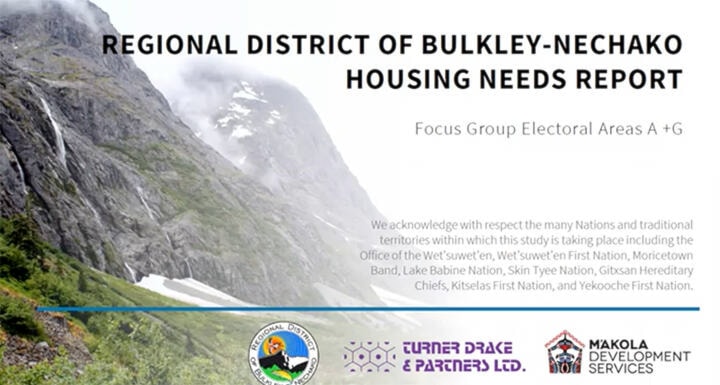The Regional District of Bulkley-Nechako (RDBN) has conducted a rural housing report for each electoral area. The report was presented to the public via various zoom sessions for each area over the course of a week. The total report is broken up into four 15-minute YouTube videos as well, with each covering two of the eight electoral area.
The data was collected by M’akola Development Services (MDS), and the videos are hosted by MDS Housing Research and Policy Lead Sandy Mackay. New provincial mandate stipulates that all electoral areas and local governments conduct a rural housing report, and this is the RDBN’s way of meeting those requirements.
Included in the report is information on demographics, households, incomes, economy and housing affordability as well as data on which income and population groups are struggling to meet their housing needs. It does not provide any indication on steps that can be taken, as it’s up to each local government to act on the information accordingly.
For the purposes of the report, the Houston rural area, electoral area G, has been grouped with the rural area of Smithers, electoral area A.
In terms of population, the total population for both electoral areas combined has virtually stayed the same over the past 15 years. In 2006, there were 6,500 people in the two areas combined, compared to 6,495 in 2021. That number is projected to grow to 7,605 by 2031.
Age distribution in the rural area has significantly risen over that time however. In 2006, 8 per cent of the population of the combined electoral areas was over the age of 65, compared to a projected 20 per cent by 2026. According to Mackay, this rise has a huge impact on the types of housing as well as services needed in these rural areas.
The average cost of ownership in the Houston rural area has gone down by 13 per cent since 2011, as it is now at an average of $140,000. In the Smithers rural area, the average cost has risen by 43 per cent, and is now at $380,000. Another interesting piece of data included had to do with tenure and income.
According to the report, 44 per cent of renters in both areas combined make under $40,000 per year in income. Furthermore, 27 per cent of renters in the Houston rural area fall into the category of core housing need, which means their home is inadequate, unsuitable or unaffordable. In Smithers, the percentage is at 17 per cent.
In addition to the data, over 15 hours of one-on-one interviews were conducted as well. The key findings from the interviews were that rental supply is high, there has been an increased cost of ownership, and there is a lack of senior specific options, as well as a lack of social and supportive housing meaning homeless shelters and addiction clinics.
To conclude the report, a survey was presented, containing 305 responses from throughout the RDBN.Of the respondents, 17 per cent indicated their current housing situation did not meet their needs, 37 per cent were worried about the cost of utilities, 32 per cent were worried about their ability to maintain an independent lifestyle, and 31 per cent were worried about distance to service and amenities.
READ MORE: Changes to CRI grant for 2022
READ MORE: RDBN allocation of COVID-19 relief fund
Have a story tip? Email:
Eddie Huband
Multimedia Reporter
eddie.huband@ldnews.net
Like us on Facebook and follow us on Twitter.
